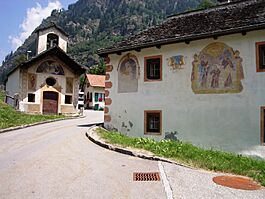Cauco facts for kids
Quick facts for kids
Cauco
|
||
|---|---|---|
 |
||
|
||
| Country | Switzerland | |
| Canton | Graubünden | |
| District | Moesa | |
| Area | ||
| • Total | 10.89 km2 (4.20 sq mi) | |
| Elevation | 992 m (3,255 ft) | |
| Population
(Dec 2013)
|
||
| • Total | 35 | |
| • Density | 3.21/km2 (8.32/sq mi) | |
| Postal code |
6546
|
|
| Localities | Cauco, Bodio, Lasciallo, Masciadone | |
| Surrounded by | Arvigo, Biasca (TI), Lostallo, Osogna (GR), Rossa, Santa Maria in Calanca, Selma, Soazza, Verdabbio | |
Cauco is a small village in Switzerland. It used to be its own municipality. It is located in the Graubünden area, which is a canton (like a state). On January 1, 2015, Cauco joined with other nearby villages like Arvigo, Braggio, and Selma. They all became part of a new, bigger municipality called Calanca.
History of Cauco
The church in Cauco was first mentioned in records in 1497. This shows the village has been around for a long time. Cauco was part of a larger area called Squadra di Calanca. In 1851, it became its own independent municipality. This means it could make its own local decisions.
Geography of Cauco
Cauco covers an area of about 10.9 square kilometers (4.2 square miles). A small part of this land, about 8.8%, is used for farming. Nearly half of the area, 49.5%, is covered by forests.
Only a small portion, 1.6%, has buildings or roads. The rest of the land, about 40.1%, is made up of non-productive areas. These include rivers, glaciers, or mountains.
The village is located on the left side of the Calancasca river. It sits at an elevation of about 1,132 meters (3,714 feet) above sea level. Cauco is built on a scree slope. This slope was formed by a huge rock slide a very long time ago. The former municipality includes the main village of Cauco. It also has smaller hamlets called Lasciallo, Masciadone, and Bodio (GR).
People of Cauco
In 2013, Cauco had a population of 35 people. A small number of these residents, about 2.8% in 2008, were from other countries. Over the last 10 years, the population has slowly decreased.
Most people in Cauco speak Italian, about 73% in 2000. German is the second most common language, spoken by 24.3% of the people. A small number, 2.7%, speak French.
In 2000, the population was almost evenly split between males and females. About 51.3% were male and 48.7% were female.
Most adults in Cauco have a good education. About 76.4% of people aged 25-64 have finished advanced schooling. This includes either high school or higher education like university.
Cauco has a very low unemployment rate, about 1.19%. In 2005, a few people worked in farming. A few others worked in manufacturing or construction. A small number also worked in services like shops or tourism.
The table below shows how the population of Cauco has changed over time:
| year | population |
|---|---|
| 1683 | c. 400 |
| 1803 | 149 |
| 1850 | 120 |
| 1950 | 92 |
| 1990 | 30 |
| 2000 | 37 |
Notable People
- Roger Sablonier (1941–2010) was a Swiss historian and writer. He taught at the University of Zürich.
See also
 In Spanish: Cauco para niños
In Spanish: Cauco para niños




